The three pillars of sustainability
The original concept of sustainability was developed a long time ago. Today, the concept of sustainability—based around sustainable consumption and production—needs to be interpreted in a comprehensive and holistic manner. The term “sustainability” also needs to embody the concept of inclusiveness. While social and economic elements complement environmental sustainability in various dimensions, there are also “tipping points” which mark the ecological boundaries for human activities.

There are different angles and directions for sustainability (Photo credit: Unsplash/Ali Kazal)
The original concept of “sustainability” comes from 17th century forestry. It means to use natural resources mindfully so that the supply never runs out, using timber resources purely for mining, construction, and heating or cooking. However, even many ancient cultures had traditions restricting the use of natural resources.
Modern definition and interpretation of sustainability
Nowadays, sustainability is a broad policy concept in the global public discourse and is thought to consist of at least three main “dimensions” or “pillars”: the environmental, economic, and social dimensions. Modern concepts define it rather as a development that “meets the needs of the present without compromising the ability of future generations to meet their own needs“ (see also Brundtland Report).
An overlapping concept is that of “sustainable development” where an important distinction is made between sustainability, often thought of as a long-term goal, and sustainable development which refers rather to the many processes and pathways towards achievement of sustainability. Sustainable development came to prominence through the United Nations Sustainable Development Goals (SDGs). The dominant issues that have been addressed in this context are related to environmental sustainability and include, for example, climate change, loss of biodiversity, environmental degradation, and pollution.
Complementing environmental aspects with the economic dimension and the crucial social pillar make sustainability an integrated and global concept that embraces our actions and our thinking.
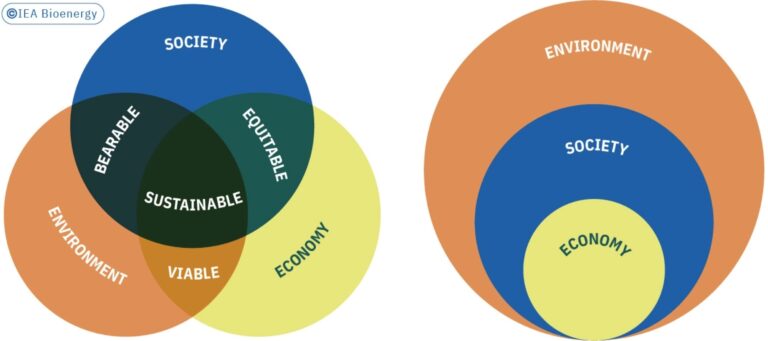
Integrated environmental, social, and economic sustainability
The integration of environmental health, social equity, and economic vitality is vital to creating thriving, healthy, diverse, and resilient communities for the present generation and those to come. Sustainability, as a concept, signifies inclusiveness, and the term is used as such by various institutions; see, for example, UCLA. Sustainability, as the concept that interconnects the environmental, social, and economic pillars and sectors, is highly complex, and any assessment of it requires a systems-based approach.
Different interpretation of the sustainability triad
One of the key observations with respect to the environmental, social, and economic sustainability pillars and how to evaluate them both singly and jointly, is that as systems grow, the number of feedback loops interconnecting different parts of the systems become particularly hard to capture and describe. In the traditional representation of these pillars as a Venn diagram, certain conditions are attained where pillars overlap. For example, if a system is optimised for sustainable societal and economic growth, equitable conditions are attained. If the conditions are optimised for the three pillars, sustainability is achieved.
It is argued that in the material reality, economic needs are nested within societal needs, which in turn must be nested within the needs of the environment, of which humans are only one component. The imbalance between the distribution of consequences clearly raises many ethical questions that need to be carefully addressed in policy design.
Limits of sustainability and the need of sustainable consumption and production
The capacity of the modern technological society to modify the environment has grown exponentially over the last century. Our capacity to restore natural systems to pristine conditions, however, remains rather limited. That limitation can be also attributed to a limited understanding of how complex natural systems behave, how they react to changes in physical, chemical, and biological conditions, and what their individual and collective tipping points or points of no return to stability are.
With humans consuming more resources than ever before, the United Nations Environment Programme (UNEP) emphasises that current patterns of development across the world are not sustainable. One of the key elements for achieving sustainable development is the transition towards Sustainable Consumption and Production (SCP). SCP is about fulfilling the needs of all while using fewer resources, including energy and water, and producing less waste and pollution.
This approach can contribute to almost all SDGs including, first and foremost, poverty alleviation and the transition to a low-carbon and green economy. This approach need to be holistic and collaboration between multiple areas and stakeholders is also required. Policies must aim not just at improving production, but also at encouraging consumers to move towards sustainable consumption choices. Thus, everyone in society has a role to play in this transition including governments, educators, the private sector, and the consumer.
- Gadde B, Bonnet S et al. (2009) Air pollutant emissions from rice straw open field burning in India, Thailand and the Philippines, Environmental Pollution 157 1554–1558 LINK
- Environment & Society Portal LINK accessed 18/02/2022
- Report of the World Commission on Environment and Development: Our Common Future From One Earth to One World LINK accessed 18/02/2022
- United Nations Department of Economic and Social Affairs Sustainable Development, Sustainable development goals LINK
- Giddings B, Hopwood B et al. (2002) Environment, economy and society: fitting them together into sustainable development. Sustainable Development 10, 187-196 LINK
- University of California, Los Angeles, What is Sustainability? LINK accessed 18/02/2022
- The Pennsylvania State University, Reevaluating the Sustainability Triad LINK accessed 18/02/2022
- The Pennsylvania State University, Natural Limits and Conditions of Sustainability LINK accessed 18/02/2022
- UNEP (2015) Sustainable Consumption and Production A Handbook for Policymakers LINK accessed 18/02/2022
4 Social sustainability and the need for a just transition
The sustainable development goals shall ensure a just transition of the energy sector
As well as its positive impact on climate change and the environment, the use of biomass can have various economic and social co-benefits, mostly in the form of cross- fertilising synergies. The bioeconomy sector is expected to play an important role in the implementation of the United Nations 2030 Agenda for Sustainable Development and for achieving its ambitious goals (SDGs). The different biomass supply chains contribute to the SDGs in a great variety of ways.

Replacing traditional biomass use by modern bioenergy can improve living conditions dramatically and is key for implementing the UN 2030 Agenda (Photo credit: Shutterstock / Riccardo Mayer)
The important inter-linkages between the SDGs and the bioeconomy
The SDGs provide a normative framework for activating a sustainable world by 2030, fostering planetary peace, justice, and improved prosperity for all. A major role in the transition to sustainability is being played by the bioeconomy, including the bioenergy sector. Indeed, according to IEA Bioenergy, 15 of the 17 SDGs are directly or indirectly linked to the production and use of biomass. Given their inherent complexity and interconnected nature, the SDGs will not be achieved one by one but in an integrated manner. Sharing successful examples is one of the ways of accelerating progress.
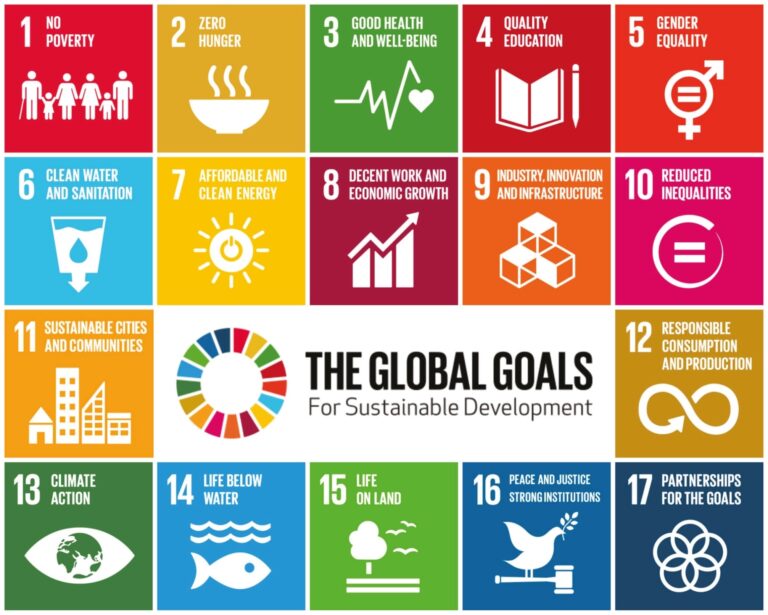
A bioeconomy-embedded bioenergy sector can achieve diversification of the energy supply and improve energy access. It can also support sustainable agricultural practices and forest management, reducing the risk of losses due to storms, insect infestations or wildfires, decreasing land and ecosystem degradation, boosting economic development in rural areas, improving waste management, and creating jobs (see also Chapter 2.4: Bioenergy as a driver for certification and conservation).
For these reasons, the wider bioeconomy, including the bioenergy sector, can play an important role globally in the implementation of the UN 2030 Agenda for Sustainable Development, and the achievement of the SDGs.
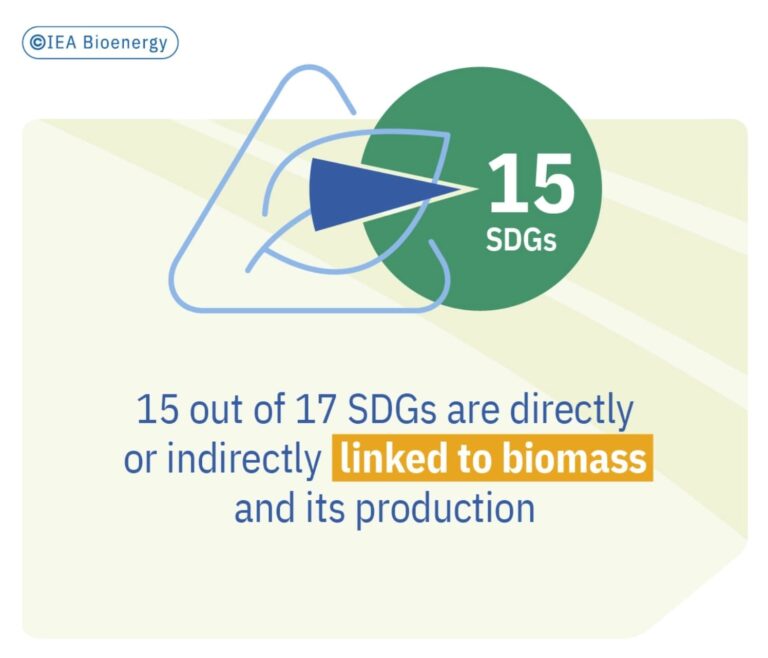
The development of holistic policies that address environmental, social, and economic priorities is key to achieving sustainability. Sustainable production of biomass for bioenergy—or any other bio-based product for that matter—encompasses growth, harvest, collection, storage, transport, processing, and use, and it can also have significant environmental, socioeconomic, and health impacts for people and their communities.
Forest-based biomass residues and the SDGs
Insights from 10 international case studies including harvest residues such as treetops, branches, and unmerchantable stems, as well as wood processing residues such as wood chips, sawdust, and shavings:
Relevant SDGs: 3,4,6,8,9,11,12,13,15
- Biomass sourced from forests that are sustainably managed can ensure the protection of ecosystem services (e.g., water purification, soil stabilisation, biodiversity conservation).
- Biomass sourced through stand improvement techniques (e.g., thinning) can simultaneously increase growth rates, improve carbon sequestration, and reduce natural disturbances (e.g., wildfires, pests).
- Use of residues, if previously discarded as waste materials, can improve resource-use efficiency and help replace fossil-based energy generation.
- Use of biomass for bioenergy can improve energy security and resiliency, while also improving the share of renewable low-carbon energy.
- Biomass can provide new economic and job opportunities for communities and regions, as forest biomass supply chains typically require more labour than fossil fuel-based supply chains.
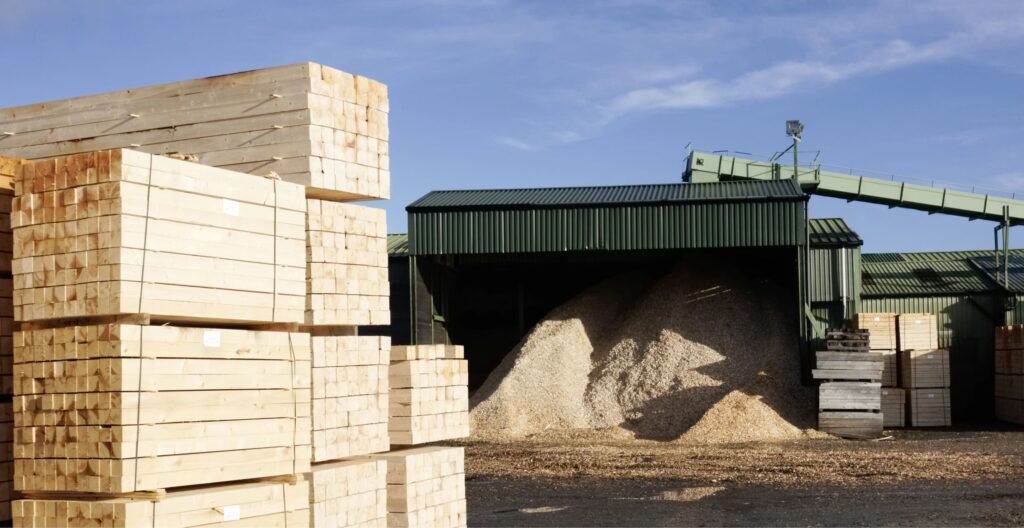
Agriculture-based biomass residues and the SDGs
Insights from 11 case studies including biomass remaining after crops are harvested (e.g., wheat straw, rice straw, cane straw, and corn stover) and also including food- or feed-processing residues such as corn cobs, olive pits, or grape marc:
Relevant SDGs: 1,2,3,5,6,8,9,10,11,12,13,15
- Use of residues can improve resource-use efficiency, especially if sourced from waste and by- product streams of primary production, as long as enough residues are left to maintain soil health and productivity.
- Redirecting residues to bioenergy away from disposal piles and open-air burning can improve local air and water quality.
- Residues that would otherwise add to excess fuel loads can help reduce the destructive effects of pests and wildfires and support other perennial management goals.
- Use of residues for bioenergy can improve energy security and resiliency, while also improving the share of renewable energy.
- Mobilisation of residues in rural areas can support sustainable economic development and job opportunities related to perennial management and biomass collection, transportation, processing, and use.
- Removal of a portion of residues from high-yielding agricultural croplands can enable the use of no-till practices which would otherwise be impractical.
Agriculture-based energy crops and the SDGs
Insights from 12 case studies including crops purpose-grown for bioenergy production are listed below. Emerging energy crops are most often perennial and can be woody (e.g., poplar or willow) or herbaceous (e.g., switchgrass). Annual cover crops can also be used for bioenergy.
- Energy crops integrated into good farming practices or other land management practices such as landscape management, can improve ecosystem functioning by improving local soil and water quality, reducing and filtering agricultural run-off, reducing soil erosion, diversifying land cover, and increasing soil carbon storage.
- Energy crops can help to reclaim degraded land, restoring land and soil tilth and bringing nutrients and carbon back into soils.
- Energy crops can also provide new sources of incomes for farmers, land owners, and land managers on less productive lands; they can provide new economic and job opportunities in the community, given that growing, harvesting, transporting, and processing energy crops are
frequently labour-intensive. - Use of energy crops to improve the share of renewable energy can improve energy security and resiliency.
Biogenic waste and the SDGs
Insights from four case studies on waste of biological origin, which includes primarily animal (manure) and household, commercial, or municipal organic waste:
- Biogenic waste used for bioenergy can improve both resource use efficiency and waste management, while reducing methane emissions, solving waste problems, and providing value- added services such as bioenergy generation.
- Biogenic waste used for bioenergy can also create useful co-products, such as biochar or digestate that can be used in agriculture to reduce the use of synthetic fertilisers and to improve the overall circularity of supply chains.
- Removing biogenic waste can reduce potential contamination of local/regional waterways.
- Biogenic waste used for bioenergy can not only improve energy security and resiliency of communities and regions but also improving their share of renewable low-carbon energy.

Bioenergy-related GHG removal technologies and the SDGs
Bioenergy is currently the largest source of renewable energy globally. Demand for bioenergy is expected to increase as countries look to sustainable low-carbon energy alternatives to support their national climate change mitigation strategies. Long-term scenarios to reduce global warming include an important role for biomass and sustainable bioenergy in implementing negative carbon emission technologies. Land-based Greenhouse Gas Removal (GGR) technologies, including bioenergy, have a particularly strong and positive interaction with the environmental and social aspects of sustainability. Given its foreseeable importance, bioenergy combined with carbon capture and storage (BECCS), as well as biomass-based biochar production and use, will create further demand for biomass resources (see also Chapter 5.1).
Bioenergy combined with carbon capture and storage (BECCS) in the SDG context
In the case of BECCS, the production and use of bioenergy mainly raises issues about potential trade-offs between economic development and sustainability, as well as potential conflicts for land between energy and non-energy uses. BECCS delivers two primary functions: energy production and carbon sequestration. BECCS can be used to produce power and/or heat, refined liquids, hydrogen, and biomethane, all of which can be used in the provision of energy services. The BECCS system removes carbon from the atmosphere as plants absorb CO2 when they grow, and (part of) this carbon can be stored (i.e., not released back in the air), which reduces CO2 concentrations.
- Biomass provision, energy production, and payments for carbon sequestration can provide additional options for local income creation for farmers and forest owners. If BECCS replaces fossil energy use, it can also reduce air pollution, as the carbon capture and storage component of the energy plant removes air pollutants as well as CO2.
- Large-scale production of biomass based on dedicated crops, and hence the potential additional fertiliser input, needs to be monitored to protect and maintain ecosystem services such as clean water and sanitation.
- Replacing fossil energy with BECCS can enhance affordable and clean energy through decreases in air pollution and CO2 concentrations and thus produce an additional positive impact on health.
- Sustainable feedstock production for BECCS both from forest and agriculture can create new income opportunities for rural land owners and the labour force, thus helping to support rural livelihoods.
- With 2.5 billion people in the world relying on agriculture and forestry for work, biomass production for BECCS can be expected to contribute to the creation of green jobs.
- If BECCS is developed carefully and sustainably, small-scale farmers and forest owners can also benefit.
- If BECCS is managed well (e.g., sustainable development of bioenergy cropping systems, sustainable and multi-purpose forest management, focus on sustainable biomass residues), negative impacts on ecosystems and their services and competition for land and food production can be avoided.
Biochar in the SDG context
Recycled agricultural and forestry biomass residues serve as feedstock for biochar—a solid product of biomass pyrolysis. Biochar has a greenhouse gas removal (GGR) potential that is similar to that of BECCS. Biochar production avoids competition for land when used in agricultural soils in the (sub)tropics due to the possible yield increases it provides. Biochar production from biomass residues also eliminates the need to set aside dedicated land for its production, thus contributing to the self-sufficiency of communities. Biomass feedstock residues for biochar can come from forests, mills, crop residue, or urban wastes.
Relevant and positive contribution to SDGs: 1,2,3,6,7,8,9,10,11,12,13,15
- Biochar brings reduced costs and dependency on external resources, together with increased crop productivity, that would help farmers be self-sufficient while increasing incomes.
- Food security will benefit from higher food crop yields and higher agroecosystem resilience.
- Biochar application to soils can increase crop yields, aid soil remediation and water purification, and thus contributes significantly to people’s nutritional health.
- Biochar can adsorb soil pollutants, thus reducing leaching and thus water pollution.
- The high recalcitrance of the organic C in biochar, together with the decrease in N2O and CH4 emissions from soils amended with biochar (through mobilisation/incorporation into new plant matter biomass or microbes etc.) contribute to climate regulation.
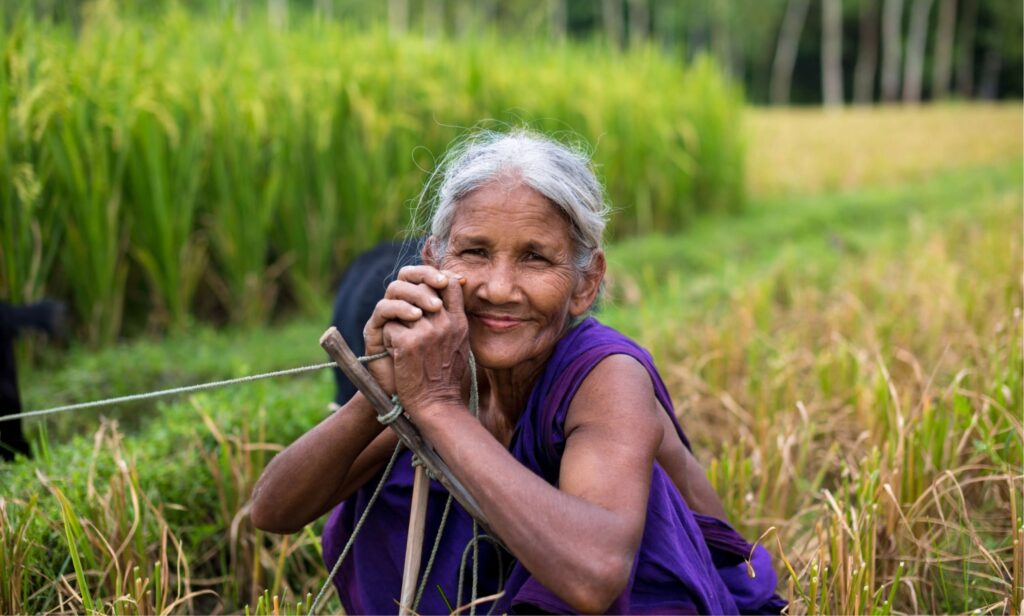
Final considerations with respect to bioenergy and the SDGs
There will always be a need for carbon in society, in the long term, too, but this must be renewable carbon, which can be provided by regenerated biomass. There are impacts and potential risks associated with biomass (including potential non-sustainable production, direct and indirect land use change, etc.). These, however, can be managed in a sensible way through sustainability governance that will ensure no net loss of carbon from the biosphere (soils, forests, vegetation) into the atmosphere.
The implementation of sustainability governance is based on the fact that bioenergy systems are commonly components in value chains or production processes that also produce other bio- based products, such as food, feed, and fibre. An assessment of the biomass value chain, and particularly its bioenergy aspects, need to be based on a holistic perspective that recognises a multitude of societal objectives and should promote options that contribute positively to the implementation of the SDGs.
- United Nations Department of Economic and Social Affairs Sustainable Development (2015) Transforming our world: the 2030 Agenda for Sustainable Development LINK accessed 18/02/2022
- IEA Bioenergy (2019) Governing sustainability in biomass supply chains for the bioeconomy – Summary and conclusions from the IEA Bioenergy workshop, Utrecht (Netherlands), 23 May 2019. LINK
- UNIDO, United Nations Industrial Development Organization (2021) The role of bioenergy in the clean energy transition and sustainable development lessons from developing countries LINK accessed 18/02/2022
- United Nations Department of Economic and Social Affairs Sustainable Development, The 17 goals LINK accessed 18/02/2022
- IEA Bioenergy (2021) Biomass Supply and the Sustainable Development Goals. International case studies. LINK accessed 18/02/2022
- Smith P, Adams J et al. (2019) Land- Management Options for Greenhouse Gas Removal and Their Impacts on Ecosystem Services and the Sustainable Development Goals. Annual Review of Environment and Resources 44 (1): 255-286.LINK accessed 21/06/2022
